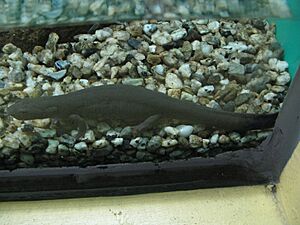Paramesotriton labiatus facts for kids
Quick facts for kids Paramesotriton labiatus |
|
|---|---|
 |
|
| Conservation status | |
| Scientific classification | |
| Genus: |
Paramesotriton
|
| Species: |
labiatus
|
| Synonyms | |
|
|
The Paddle-tail Newt (scientific name: Paramesotriton labiatus) is a cool type of newt that belongs to the Salamandridae family. Newts are small amphibians, a bit like lizards, but they live in water for part of their lives. This special newt is found only in Guangxi, China.
Before 2011, people sometimes mixed up the Paddle-tail Newt with other similar newts, like the Chinese Newt or the Granulated Newt. But now we know it's its own unique species! It has many fun nicknames, including Unterstein's Newt, Spotless Stout Newt, and Zhao Ermi's Smooth Warty Newt.
Contents
All About the Paddle-tail Newt
What Does a Paddle-tail Newt Look Like?
The Paddle-tail Newt gets its name from its long, flat tail that looks a bit like a paddle. This helps it swim! Their bodies are quite flat too. They can be different colors, from dark black to brown or even a pale brown.
If you look closely, you might see bright orange markings on the bottom of their bodies. Some even have orange dots along their backs. Their skin feels very smooth because it has a special mucus coating. They also have relatively short legs. These newts can be as big as, or even bigger than, a similar newt called Pachytriton brevipes.
How Paddle-tail Newts Find Food
Paddle-tail Newts use two main senses to find their meals: their eyesight and their amazing sense of smell. In the wild, food can be hard to find, so these newts are super tough! They can actually go for many weeks without eating anything. However, if they are kept as pets, it's important to feed them regularly to keep them healthy.
How Long Do Paddle-tail Newts Live?
Scientists don't know exactly how long Paddle-tail Newts live in their natural homes. But when they are cared for by people, they usually live for a long time, often between 10 and 20 years! That's a pretty long life for a small amphibian.
How Paddle-tail Newts Communicate
One really interesting thing about Paddle-tail Newts is how they talk to each other. They don't make sounds like some animals. Instead, they use their tails! When they want to get another newt's attention, or if they get scared, or even when another newt comes close, they will fan their tails. It's their special way of sending messages!
Paddle-tail Newts and Other Newts
Sometimes, people confuse Paddle-tail Newts with another type of newt called the Japanese Fire Belly Newt. They might even be sold by mistake as Fire Belly Newts. But Paddle-tail Newts are much bigger! They are also more aggressive, which means they can be quite feisty. If a Paddle-tail Newt is given the chance, it might even try to eat smaller Fire Belly Newts.
There's also a close relative to the Paddle-tail Newt called the spotted paddle-tail newt.


